#British fossil
Explore tagged Tumblr posts
Photo

Fossil Reptile Bones & Coprolite – Upper Triassic – Aust Cliff, Westbury Formation, Bristol UK
Fossil Reptile Bones and Coprolite in Matrix – Upper Triassic – Aust Cliff, Westbury Formation, Bristol, UK
This exceptional block contains genuine reptile bone fragments and an accompanying coprolite (fossilised faeces), preserved together in a matrix from the world-famous fish, reptile, and coprolite bed at Aust Cliff, Bristol. This geological unit, known as the Westbury Formation, is part of the Penarth Group and dates back to the Upper Triassic Period (around 205–210 million years ago).
Scientific and Geological Context:
Location: Aust Cliff, near Bristol, UK
Formation: Westbury Formation
Group: Penarth Group
Geological Period: Upper Triassic
Depositional Environment: Coastal lagoon/estuarine system subject to episodic flooding and anoxic conditions, perfect for preservation of organic material
Lithology: Dark laminated mudstones and siltstones with fossil-rich horizons
Palaeoecology: Rich with vertebrate remains including fish, early marine reptiles (e.g. placodonts and ichthyosaurs), and evidence of terrestrial vertebrate activity via coprolites and bone beds
Fossil Features and Significance:
The coprolite is thought to originate from a carnivorous vertebrate and often contains inclusions such as crushed bone fragments, giving insights into the diet of Triassic predators. The reptile bones in this block may represent fragments from marine or marginal marine reptiles that inhabited or were washed into the depositional basin.
Morphology Highlights:
Long, cylindrical coprolite with preserved texture and mineral replacement
Bone fragments exhibit porous internal structure typical of vertebrate remains
Notable Use: Coprolites from this bed are significant for palaeoecological reconstructions and are used to study trophic chains in Late Triassic environments
Specimen Details:
Discovered by: Our own team – Alister and Alison – on 07 April 2025
Cleaned, prepped and treated by: Alison
Scale Reference: Cube in image = 1cm; full size detailed in photographs
Authenticity: Supplied with a Certificate of Authenticity – we guarantee all our specimens are 100% genuine
Photographed Specimen: What you see is exactly what you get – carefully chosen, clearly shown
Why This Specimen?
This is an ideal piece for collectors, educators, and anyone with an interest in prehistoric life. With both reptile bone and coprolite in situ from a stratigraphically and scientifically important UK fossil bed, it’s a rare and insightful snapshot of Triassic life.
#fossil reptile bones#Triassic coprolite#Aust Cliff fossil#Westbury Formation fossil#Penarth Group#reptile coprolite#Upper Triassic fossil#genuine fossil#UK fossil bed#dinosaur-era fossils#fish reptile coprolite bed#fossil block#authentic fossil bones#British fossil
0 notes
Text
Paleontologists have uncovered dozens of fossils in northern B.C., only one of which came from a dinosaur that was previously known to that area. Victoria Arbour, curator of paleontology at the Royal B.C. Museum, said it was her team's third time to the Spatsizi Plateau Wilderness Provincial Park, about 200 kilometres south of the B.C.-Yukon border. The area is rough terrain, so the team has to be flown in by helicopter. Usually, well-preserved dinosaur bones are found in deserts, where rocks are exposed, but Arbour said that on this particular mountain, her team hit the "mother lode of fossils."
Continue Reading
Tagging: @newsfromstolenland
257 notes
·
View notes
Text
For #NationalTeaDay 🫖☕️:


Teapot with Fossil Decoration British, Staffordshire, c. 1760–65 Salt-glazed stoneware with enamel decoration 4 1/4 × 7 1/4 in. (10.8 × 18.4 cm) The Metropolitan Museum of Art, New York 37.22.6a,b
“Though it's got a surprisingly modern look, this teapot was made in the 18th-century in Staffordshire—the heart of Britain's pottery industry. The area’s limestone yielded prehistoric fossils, and potters often turned them into whimsical motifs for teapots.”
#animals in art#european art#British art#decorative arts#ceramics#Staffordshire#pottery#teapot#National Tea Day#tea kettle#monochrome#black and white#fossil#fossils
305 notes
·
View notes
Text




The Mighty Boosh // S03E06: The Chokes
#The Mighty Boosh#Mighty Boosh#Bob Fossil#Rich Fulcher#Howard Moon#Julian Barratt#The Mighty Boosh Gifs#Gifs#Television#Television Gifs#Comedy#British Comedy#AVTheMightyBoosh
66 notes
·
View notes
Text
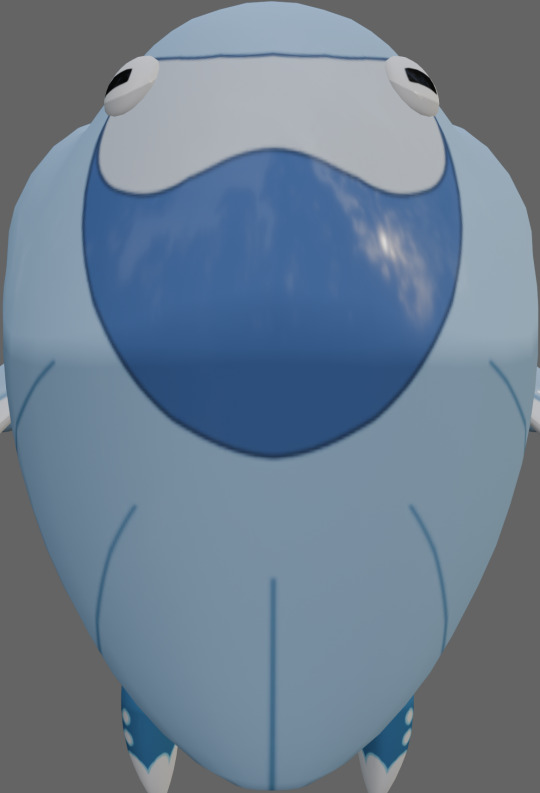
#this one's dex entry also states that it has “breathing difficulties”? what the fuck. why are all the -vish pokémon suffering#arctovish#i guess i would be suffering‚ too‚ if i died and became a fossil and then thousands of years later some british kid resurrected me#using my head on top of someone else's body#that's. fucked up to think about i don't think i'm gonna think about that anymore
87 notes
·
View notes
Text
BP is expected to ditch a target to ramp up renewable energy generation by 2030 as part of a shift back towards fossil fuels when it presents its strategy to investors this week.
The chief executive, Murray Auchincloss, is poised to tell shareholders that the oil and gas company is scrapping its target to increase renewable generation 20-fold between 2019 and 2030 to 50 gigawatts, Reuters reported.
At an investor day in London on Wednesday, the company is likely to announce plans to divest assets and cut other low-carbon investments to reduce debt and increase returns, under mounting pressure from shareholders.
The company has already scaled back its target to reduce oil and gas output – set by Auchincloss’s predecessor Bernard Looney – by the end of the decade. In 2020, the last time it presented a comprehensive strategy update, it aimed for a 40% reduction, but changed this to a 25% reduction in 2023, and is expected to reduce it further on Wednesday.
Other energy companies such as Shell have renewed their focus on oil and gas, chasing better returns after fossil fuel prices bounced back from pandemic lows, and after Russia’s full-scale invasion of Ukraine three years ago. The investor environment has also changed with the re-election of the US president, Donald Trump, a strong advocate of fossil fuels.
Since taking over, initially on an interim basis in September 2023, Auchincloss has scaled back investments in renewables and diluted BP’s climate pledges. He is also pushing through $2bn of cost cuts, which include cutting thousands of jobs and scrapping contractors to reduce the workforce by 5%.
#there's a fury in me#even if there's not a shock#british petroleum#fossil fuels#climate change#capitalism#excerpts
13 notes
·
View notes
Text
Throwback Thursday: Charles Walcott and the Burgess Shale
In typical field paleontology fashion, the field season was nearly over when Charles Walcott made the biggest discovery of his life.


It was August 1909 in British Columbia and he was on a steep mountain slope when he found the first fossils of the now world famous Burgess Shale.

Between 1910 and 1924, Walcott collected over 65,000 specimens. He described as many as he could until his death on 1927.
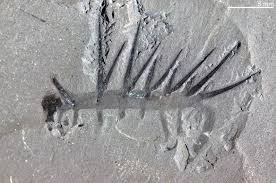

Today, the Burgess Shale is best known for its exceptional preservation of hundreds of soft-bodied animals. At least 172 different animals have been identified including Hallucigenia (pictured above and to the left) which Walcott had reconstructed upside down. To be fair, we have nothing like that alive today and the one he had found hadn't preserved all of the little feet or lobopods.
If you want to know more about the Burgess Shale, you can click this link:
This website is amazing and will take you on a fun filled adventure. It gives you taxonomy of each animal, discovery info, sometimes even a three dimensional rendering of the animal in it's habitat.
#paleontology#fossils#fun facts#geology#history#cambrian period#cambrian explosion#science education#science#charles walcott#burgess shale#british columbia#canadian rockies
19 notes
·
View notes
Text
#australia#biodiversity#biodiversity loss#birds#british columbia#canada#candice gaukel andrews#caribbean#climate change#conservation#cuba#dinosaurs#elephants#england#environment#extinction#florida#forests#fossils#global warming#greenland#ice sheet#madagascar#mollusks#natural habitat adventures#nathab#nature#new zealand#pangae#penguins
4 notes
·
View notes
Note
"#...though everything in me wants to analyse the intersection of power and species in this film I must grit my teeth and acknowledge it is#Not That Deep and british ecology will have no meaning in a fun little film adaptation from the 50's"
No, please keep talking. This is the shit I live for! Okay, we know the truth is that is makes zero sense, but trying to make sense of it sounds very fun.
My own tuppence worth on the subject is just noting that the film would have taken place only about 100 years after the Norman invasion, which presumably in this Disney animal 'verse means that lions and other non-native predators would have been in every major position of power for all of living memory. It makes me wonder if Marian being a fox could mean she was descended from and Anglo-Saxon noble line that was deposed by the Normans. This could then add to the reading of invasive species (the rich and nobility) harming the entire ecosystem of society by over-exploiting native species.
So we have a story of the trickster non-apex predator who fits into this ecosystem, who belongs there due to having a place in the multi-species (multicultural) society versus the invasive apex predator who is a symbol of royalty, divinely appointed, and yet he is very much not a real part of this community he would nevertheless rule.
As a Brit, it's pretty reflective of how the nobility of the UK still works nigh on 900 years on. It's not anti-immigrant (see the bloody tortoise character, which is definitely a non-native species) but I read it as a condemnation of people with power and status who are so removed from the common people they rule that they may as well be of another species from another continent.
King Richard returning at the end kind of undercuts this reading, though, so I am definitely trying to shove my anti-monarchist views into a narrative not made to accommodate them.
Anyway, please share your thoughts on this, I need someone else to go way too deep into things with!
@the-phony-king-of-england
You are both wonderful, terrible enablers and I adore you.
Honestly Lancre you've pretty much nailed the historical implications I was trying to articulate in my own brain - that of the rich being animals that do not suit the area they're occupying.
Be warned I'm going to expand on this via an ecological wandering ramble below with no clear conclusion, so yay???
This. Gets. LONG.
(Also I'm shaking hands with you tightly, Brit for Brit on monarchial views here)
Aight ok. Basics first.
The Disney 70's (not 50's, my bad) Robin Hood is a loose adaptation of various folktales regarding Robin of Sherwood, who's tales originate at earliest, from the 1100's, and stretch to the 1500's. Robin as a singular figue never likely existed as just one person, and instead is a conglomerate of various daring, altruistic thief figures of semi-dubious origin. Dubious because this is medieval England and there ain't much to do but get piss drunk and swap tales around the pub fireplace, so there's always an element of inaccuracy and exaggeration for entertainment.
The setting of the story takes place in the city of Nottingham, and the surrounding Sherwood Forest. Both of which still obviously exist, though Nottingham is obviously MUCH larger than it was, and the forest has been reduced to mostly pine plantations and scattered ancient remnants of the original woodland.

There's no map for the medieval borders of the forest becuase officials were relying on collective memory and physially walking around the wood occasionally to demark it's location, but guesstimates would move he green area on the left image to encompass Nottigham and widen the forest eastwards a bit too.
The above reduction in size makes me smad, but that's beside the point. Sherwood in all it's medieval 100,000 acres was a royal wood - permissible to hunt in ONLY for the King and his fave besties. This is a point I'll come back to later. There was 1 (ONE) road to london south through it, and that road was prime time for Robin & co. to do as they do best, as we see in the opening scenes of Disney's adaptation.
The disney adaptation uses anthropomorphic animals to depict the typical robin hood story.
This is where my little conservation-masters-equivalent-certificate having bum starts to get it's knickers in a twist.
Like. I get it. On a folklore and symbolism level, the basic animals make sense. Robin is a red fox, a figure in British folklore often associated with cunning, trickery and swiftness - making him a perfect rackish protagonist, an outlaw with a heart of gold. Foxes are known to steal, and adapt very well to both modern urban environments and the medieval woodlands and fields. Brilliant choice, no notes.
John.
...John.
*deep sigh*
I KNOW. Our national animal and symbol for royalty is a lion. I KNOW. John and Richard being lions is a direct tie in to the lion coat of arms of the Duchy of Aquitaine, one of the ruling families to invade as part of the norman invasion. John even speaks french on occasion in the film, and directly refers to it as 'the norman' way! I GET IT.
That we have not had any lions, much less the african lion alive today, living on our island since the last glaciation period is something I'm still bitterly annoyed about, but whatever. It's fine.
That this also implies that Normandy, aka modern France, has a thriving population of lions running about in some fusion of french temperate flats and the kenyan savannah is something I just have to grit my teeth and nod about, but WHATEVER IT'S F I N E -
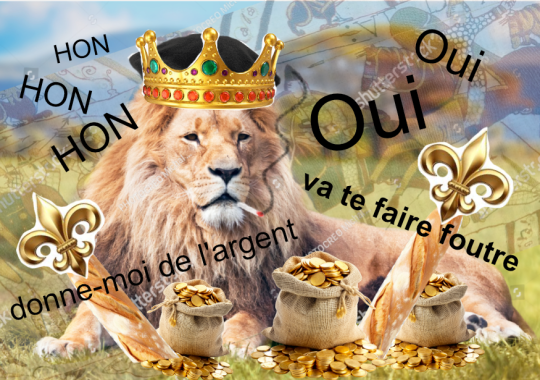
*Insert aggressive bardcore accordion music here*
Ugh. Moving on.
Ecologically, and story wise, it would make most sense for the denizens of Nottingham to be anthropomorphised as animals native to the region. And for the most part this holds up. We have the rabbit family, the mice, the owls, blacksmith dog, the singing rooster and Lady Cluck the Chicken, who has my WHOLE heart in this film. Friar Tuck is allegedgly a badger...
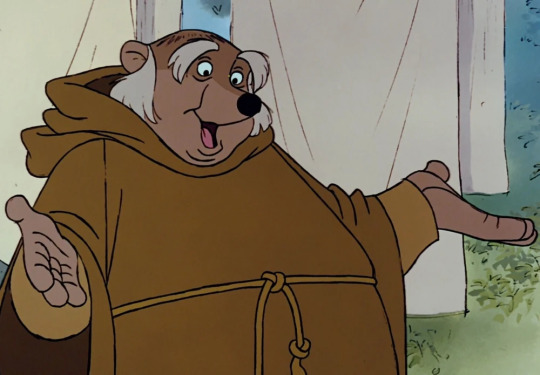
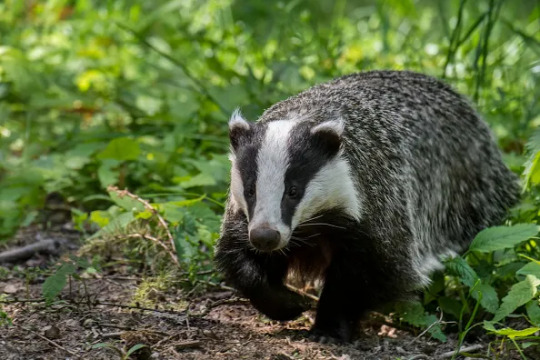
...which I doubt, but I'll allow it I guess. (I would prefer the black & white be actually depicted, and for the man to have claws. Let him have his claws he deserves them.)
Then...we have Little John.
British ecology is famous as being incredibly lacking in the modern day, due to a combination of land management changes, hunting, climate change and our being an island nation. All our major carnivores are extinct, and have been for a long time.
John is a brown bear.
Brown bears have been extinct in Britian for over 1000 years.
Even at the earliest possible time of the film, brown bears will have been dead for 200 years. John's existence should have been something almost goddamn-messiah like in this film. Last of the giants type stuff. I'd love for Lancrew's above point of large british animals to have been defeated 100 years prior by Norman invading lions (deeeeeeeep sigh) to hold up here and have John be a last descendant of nobility. He's a common man in all the legends, but it would be a great addition to how he schmoozed John at the archery tournament.
Looking at Johns forces now instead...
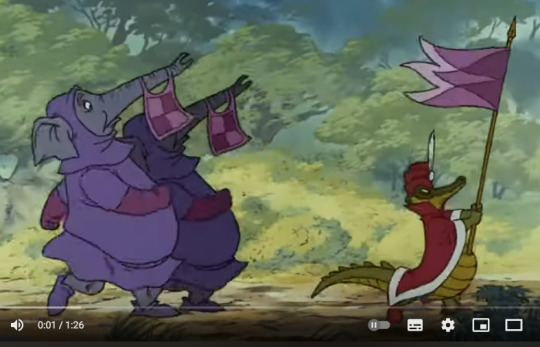

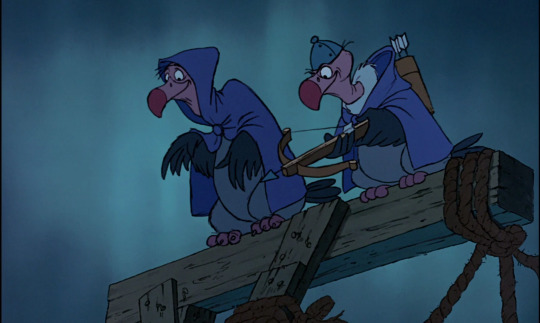
...what the FUCK is going on.
This, I GUESS, is an easy hand wavy way to visualise bad guys vs good guys. Cute forest critters vs afro-french (DEEP SIGH) mega herbivores & carnivores shows an obvious power inbalance between the local animals and Johns forces, and explains why the townsfolk can't rise up on their own. Rabbits aren't exactly going to do much against halberd weilding plate armoured legions of Rhinoceros.
BUT GOD ALMIGHTY WE COULD HAVE TRIED FOR EUROPEAN FAUNA, AT LEAST A LITTLE BIT???
Easy stuff first. Sir Hiss looks about 1, maybe 1.5 meters long, is green, and has no allusion to venom in the film. I've got him down as a grass snake, our largest species. Excellent. No notes.
The wolves are also easy. Wolves didn't go exinct in England until the 1500's, and alledgedly survived in Scotland until the 1700's. While I personally dislike the depiction of wolves as purely villainous in media, here the Sheriff and his men are the perfect foils to Robin. A larger canine species, moving in packs and hunting him in his own woods (that he's SQUATTING IN, because the woods are owned by John and the crown!), and exempliying the selfishness of the crown by having the Sheriff be dressed in bright colours, with fashionable sleeves while the townsfolk are in rags.
Also aside from the Friar, who is fat in every depsiction of the story, the Sherriff is noticably overweight compared to his men and the pallid, sickly looking townsfolk. The fact his clothes fit him when he's a body type almost no-one else has is a great further subtle show of proof that he's living indulgently and comfortably in his life of active cruelty enforcing John's will, and has no intention of stopping.
His other soldiers....
...ok. Since Lady Cluck - a chicken - is half the size of brown bear little John, there's some leeway for size. The vultures I think could feasably have been ravens, magpies or crows: still a little subtly morbid still, fitting for guards. Or maybe storks or herons, or even seagulls! To keep the silly antics and mean streak.
I- look. The rhino's are the main kind of guard featured. They're big, they're strong, they're imposing to look at and occasionally bumbling.
European Bison were RIGHT THERE.
Pigs and wild boar are depicted as background characters in a couple of scenes. do. Do you have ANY idea how large wild boar can be? Especially 500+years ago?! These things FUCKED. And they actively fucked you up when they wanted to. This wouldn't even be a case of british animals being wiped out in the wars - these things were prevalent all over Europe!
WHERE ARE THE DEER. The penultimate prey species for large cats?????? Not a single goddamn doe or stag have I seen in this film?? Sherwood Forest was a DEER HUNTING FOREST?! Not even as soldiers, Robin should have been able to help anthropo-medieval Bambi away from the wolves at least once.
I am not going to even fucking talk about the crocodile. Madam, in whose climate? We can barely keep 3 species of finger-length lizard alive through our wet, cold, windy climate, howmst the FUCK-
My only course of action is to admit that at some point in this universes timeline: There rose a kingdom of immense power in East Africa that has since, over many generations, colonised northwards and subjugated/wiped out European ecosystems. They reached the british isles around the medieval period, and now thanks to Prince John and Sir Hiss hypnotising King Richard, they are continuing expansion eastward via the crusades.
The vultures are there to eat the carcasses of the conquered nations armies. There. Evil as fuck but also exonomical.
Do Not Speak to Me About The Raccoons.

As far as I'm concerned these are oddly coloured red squirrels.
I hope you enjoyed this absolutely insane spiel of nonsense.
#thalassa responds#disney villains#Disney Robin Hood#Prince John#sir hiss#robin hood 1973#I have FAR too many thoughts abouth this film#like yes! Cute film absolutely 1000% is not that deep#but the ecological implications????#If humans had never evolved - or stuck around after Britain became an island we likley would have a 'complete' ecosystem with top carnivore#so maybe we would still have the lions and hyenas the fossil record shows 10'000 years ago#as well as megaloceros#but we're the top predator here now and all depictions of anthropomorphised british life never get this#if you remove the humans for animal characters - yet don't have any of the top predators anthropomorphised - then you are showing -#- an ecosystem that has either been molded by human hands or suffered a cataclysm it is still recovering from#anyway enjoy I had far too much fun with this
9 notes
·
View notes
Text
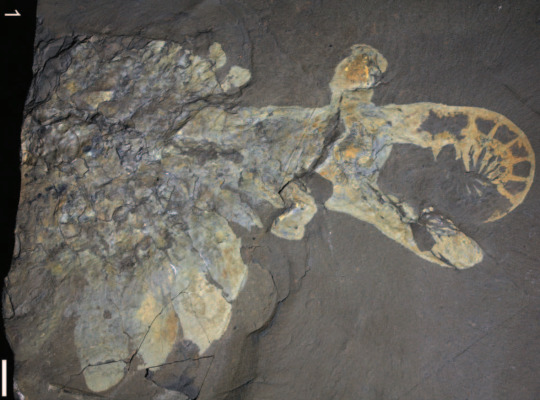

Happy Fossil Friday!
Who: Anomalocaris canadensis
name meaning: "Odd shrimp" "from Canada"
pronunciation: Ah-nom-ah-low-care-iss can-ah-den-sis
What: A Dinocarid, radiodont arthropod with two long grasping appendages and large compound eyes. A ray of wing-like projections along the trunk and fish-like tail.
When: Cambrian Period (Anomalocaris sp. ranged 516 to 505 Ma)
Where: Burgess Shales British Columbia, Canada. From the Stephen/Burgess Shale Formation.
Fun fact!: A. canadensis is the type species for the Anomalocaris genus within Anomalocaridae and bonus fun fact: Since Anomalocaris are soft bodied organisms, they do not preserve well (usually) in the fossil record, with the exceptional cases of place like the Burgess Shale in BC. For many years, palaeontologists believed that Anomalocaris was actually three separate organisms, due to the poor preservation of the "softer" portions of the body, making it seem like the frontal appendages, mouth parts, and trunk of the animal were from different creatures. Exceptionally preserved specimens like the Left image above, show Anomalocaris in full form.
(def: the "type species" is the species upon which a genus's description is based and for which the genus is named and associated with).
Why are they cool?: Apart from the charismatic (in my personal opinion "adorable") visage of this tough little arthropod, they could use their long, segmented frontal appendages to curl and grasp prey, pulling it under to the mouth to be eaten, one of the first predatory creatures to emerge during the Cambrian Explosion.
Here is a link to a video showing Anomalocaris canadensis in its natural habitat from the wonderful Burgess Shale website, for those interested, check out their other videos on Burgess Shale/Cambrian fauna.
Image Credits: (Left: Fig. 1 - Daley, Allison C., and Gregory D. Edgecombe. “Morphology of Anomalocaris Canadensis from the Burgess Shale.” Journal of Paleontology 88, no. 1 (2014): 68–91. https://doi.org/10.1666/13-067. Right: M. Cross)
#palaeontology#paleontology#fossil friday#fossils#paleo#anomalocaris#cambrian#cambrian explosion#burgess shale#canada#british columbia#arthropod#anomalocaris canadensis
25 notes
·
View notes
Photo

Rare Fossil Reptile Bone in Coprolite Bed Block – Aust Cliff, Upper Triassic UK, Penarth Group, Westbury Formation
Discover a genuine piece of deep-time history with this fossil reptile bone embedded in a block from the famous fish, reptile, and coprolite bed at Aust Cliff, Bristol. This exceptional specimen was recovered from the Westbury Formation of the Penarth Group, dating back to the Upper Triassic Period (~208-201 million years ago). It originates from one of the UK’s most iconic fossil sites, renowned for preserving an extraordinary mix of vertebrate remains in a rich depositional setting.
Your specimen was discovered on 07 April 2025 by our own expert field collectors, Alister and Alison, and meticulously cleaned, prepped, and preserved by Alison. The actual fossil you receive is the one shown in the photos, clearly scaled with a 1cm cube for accurate size reference.
This reptile bone likely belonged to one of the early marine or semi-aquatic reptiles known from the site, such as phytosaurs or early archosaurs, which thrived in estuarine and nearshore environments. The Westbury Formation was deposited in a low-energy marine lagoonal or marginal marine setting, perfect for fossil preservation.
Geological & Palaeontological Information:
Species: Indeterminate Reptilia (likely Phytosaur or similar reptile)
Fossil Type: Bone (vertebrate remains)
Location: Aust Cliff, Bristol, England
Stratigraphy:
Formation: Westbury Formation
Group: Penarth Group
Stage: Upper Triassic (Rhaetian)
Depositional Environment: Shallow marine lagoonal to marginal marine
Notable Site Facts: Aust Cliff is a classic British palaeontological site, internationally famous for its diverse vertebrate fossils including fish, reptiles, and coprolites within a condensed fossil bed at the top of the Westbury Formation.
This fossil offers a rare opportunity to own a direct connection to the late Triassic world, just before the rise of the dinosaurs in the Jurassic. Perfect for collectors, educators, or anyone with a passion for ancient life.
All of our Fossils are 100% Genuine Specimens & come with a Certificate of Authenticity.
Scale cube = 1cm. Please see the photo for full sizing.
Add this well-preserved and scientifically important specimen to your collection today – a snapshot of prehistoric life from a globally significant geological formation.
#Fossil reptile bone#Aust Cliff fossil#Westbury Formation#Penarth Group#Upper Triassic fossil#UK fossil bone#Triassic vertebrate fossil#authentic fossil specimen#reptile fossil#fossil coprolite bed#British fossil#Aust fossil bone#fossil for sale#reptile remains#Triassic paleontology
0 notes
Text
British Columbia has officially designated a large, fierce-looking marine reptile that lived 80 million years ago as the province's official fossil emblem.
The government adopted the long-necked, sharp-toothed 12-metre elasmosaur as the emblem on Thursday, adding to the list of provincial symbols.
The designation follows a five-year recognition effort by paleontology enthusiasts and a provincewide public poll in 2018, in which the elasmosaur received 48 per cent of the vote.
Full article
Tagging: @politicsofcanada
#cdnpoli#canada#canadian politics#canadian news#canadian#british columbia#BC#paleontology#elasmosaur#fossils
68 notes
·
View notes
Text
its been several weeks and im still thinking about the hard switch by owen pomery im crazyy. im going crazy. the most striking thing about such a short graphic novel for me is how harsh the world was depicted as yet how badly i wanted to be immersed in it. god. man
#if you haven't read it i recommend!!!! i picked it up in blackwell's in oxford. it's a fairly short graphic novel about some space grifters#who are struggling to scrape a living in a world where the substance that facilitates interstellar travel is running out#and despite being so short the world was just touched on enough to /feel/ expansive. idk man#i think it particulary sticks out as a piece of specifically british sci-fi. the scenario being such a clear metaphor for-#-fossil fuel extraction and climate change. and in particular climate refugees making the perilous small boat crossings across-#-the english channel. not to mention the legacy of cultural imperialism and who gets to 'own' cultural artifacts#the climax of the story did resemble more of a rolicking space opera but i don't think it cheapened the other aspects. it was so short#but yeah......idk man. it was good. well-crafted even. i can only hope to make a graphic novel as cohesive and meaningful
5 notes
·
View notes
Text

The feminine urge to pay for everything with your fairy money!
🧚🏼♀️✨💰
#history#fairy#britain#fossils#snake stones#medieval history#fairy money#stone circles#england#wales#british history#scotland#fairycore#ammonite#crinoid#prehistoric history#medieval#medieval england#feminine urge#cottagecore#fairy girl#stonehenge#word origins#british folklore#nickys facts
5 notes
·
View notes
Text




6 notes
·
View notes
Text
I LOVE FOSSIL FUELS‼️
#fossils fuel#cat#industry#industrialization#coal#coal mining#oil#micro plastics#definitely not paid for by oil companies#carbon dioxide#ozone#ozone layer#BP oil spill#oil spill#yummy microplastics#microplastics#gato#shell#BP#british petroleum#we love our coal mining jobs#global warming#climate change#climate crisis
6 notes
·
View notes